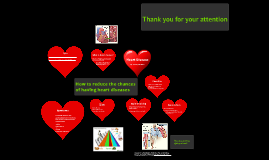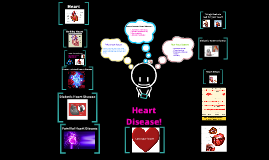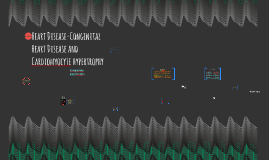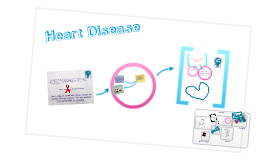heart disease
Transcript: what is heart disease? loovens francoeur 3b 4-27-12 A structural or functional abnormality of the heart, or of the blood vessels supplying the heart, that impairs its normal functioning.High blood pressure Physical inactivity Obesity and overweight Diabetes mellitus Increasing age Male sex Heredity Tobacco smoke High blood cholesterol IT INCREASES YOUR BLOOD PRESSURE WHICH CAUSES YOUR HEART TO WORK FASTER AND THEN IT STOPS CAUSE IT USED UP ALL ITS ENERGY TO BREATH AND YOU STOP BREATHING AND HAVE A HEART ATTACK More than six decades of empirical research have shown that psychosocial risk factors like low socio-economic status, lack of social support, stress at work and family life, depression, anxiety, and hostility contribute both to the risk of developing coronary heart disease (CHD) and the worsening of clinical course and prognosis in patients with CHD. These factors may act as barriers to treatment adherence and efforts to improve life-style in patients and populations. In addition, distinct psychobiological mechanisms have been identified, which are directly involved into the pathogenesis of CHD. Congestive heart failure (CHF) is the end stage of many diseases of the heart and a major cause of morbidity and mortality. The incidence of CHF is increasing steadily as treatment for its coronary antecedents, such as myocardial infarction, advances. Treatment of CHF generally relies on a battery of pharmacological interventions, alongside exercise and diet regimens. It is only in recent years that the psychological impact of heart failure has been explored, which is reflected by the absence of standardized psychological assessment for patients with CHF. In this article, we review studies that have addressed the effects of depression, anxiety, coping style, and level of social support in CHF. 2. Exercise for 30 minutes on most days of the week Getting some regular, daily exercise can reduce your risk of fatal heart disease. And when you combine physical activity with other lifestyle measures, such as maintaining a healthy weight, the payoff is even greater. Physical activity helps you control your weight and can reduce your chances of developing other conditions that may put a strain on your heart, such as high blood pressure, high cholesterol and diabetes. It also reduces stress, which may be a factor in heart disease. Obesity Obesity — Comprehensive overview covers causes, treatment and prevention of this serious health risk. Metabolic syndrome Metabolic syndrome — Comprehensive overview covers symptoms, treatment of conditions related to insulin resistance. Heart disease in women: Understand symptoms and risk factors All women face the threat of heart disease. Discover how to protect your heart. Heart disease risk calculator Heart disease risk: Use this tool to calculate your risk of having a heart attack. Stress symptoms: Effects on your body, feelings and behavior Stress symptoms — Learn how stress can affect your health so that you can take action. Symptoms Tachycardia Tachycardia — Comprehensive overview covers symptoms, diagnosis and treatment of a rapid heartbeat. Bradycardia Bradycardia — Comprehensive overview of symptoms, diagnosis and treatment of a slow heartbeat. Edema Edema — Comprehensive overview covers symptoms, causes, treatment and self-care of tissue swelling. Heart attack symptoms: Know what's a medical emergency Watch for these heart attack symptoms. Daily aspirin therapy: Understand the benefits and risks Daily aspirin therapy can be lifesaving or life-threatening. Discover if you're a good candidate. Cardioversion Cardioversion — Overview covers what to expect during this procedure to reset your heart's rhythm. Drug-eluting stents: Do they increase heart attack risk? Drug-eluting stents are generally safe if used with proper medications. Find out more. Angina treatment: Stents, drugs, lifestyle changes — What's best? Choosing angina treatment — angioplasty, stents or lifestyle changes — can be confusing. Find out more. Gene therapy Gene therapy — Overview covers definition, risk, results of this experimental procedure. Lifestyle and home remedies Menus for heart-healthy eating: Cut the fat and salt Use these menus to jump-start your heart-healthy diet. Nuts and your heart: Eating nuts for heart health Discover how walnuts, almonds and other nuts help lower cholesterol and im-prove heart health. Heart-healthy diet: 8 steps to prevent heart disease Ready to start your heart-healthy diet? Here are eight tips to get you started. Trans fat is double trouble for your heart health Trans fat raises "bad" (LDL) cholesterol and lowers "good" (HDL) cholesterol. Omega-3 in fish: How eating fish helps your heart Omega-3 fatty acids in fish are good for your heart. Find out more. Alternative medicine Chelation therapy for heart disease Chelation therapy for heart disease — Overview covers the definition and risks of this procedure. Herbal supplements may not mix with heart medicines Some herbal

















